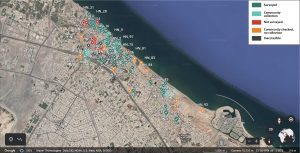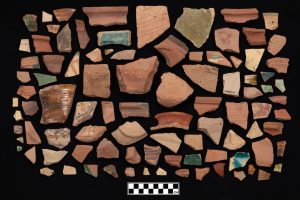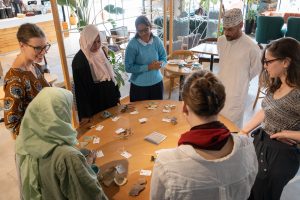May 2022 | BIPS Travel Grant
Documenting the disappearing archaeological heritage of Seeb (Muscat, Oman)
The aims of the project are to explore the threatened archaeological heritage of Seeb (a suburb of Muscat in Oman) and to build on the existing community interest in local history. We had four specific objectives:
- to define the boundaries of the historical settlement over time and to ascertain the site’s regional and trans-regional connections, in particular with Iran and other parts of the Persian Gulf;
- to record the archaeological heritage of Seeb that is vulnerable to development;
- to raise awareness of the significance of ancient Seeb within the local community;
- to support the development of public engagement as a potential future model aimed at safeguarding threatened heritage across the broader region.
 The BIPS grant was instrumental in supporting the core of the project – a three-week field-walking survey, followed by an additional week of finds processing. The survey area was mapped in advance of the project using GoogleEarth, with the help and participation of members of the local community. Pockets of undeveloped land and vacant lots were identified within an otherwise dense, residential neighbourhood. We have successfully collected material from 60 of the 104 survey plots, providing good general coverage of the area, especially towards the coast, where the archaeological remains are concentrated. The results give a preliminary indication of the extent and chronology of the medieval settlement at Seeb. The oldest, early Islamic (8th to 10th centuries) material was concentrated around the al-Rawdah Roundabout, and the distribution of middle Islamic material (11th to 13th centuries) suggests it developed from this nucleus along the coast and inland. By contrast, although late Islamic pottery has been found throughout the site, there is a notable gap in occupation spanning the 14th to 16th centuries.
The BIPS grant was instrumental in supporting the core of the project – a three-week field-walking survey, followed by an additional week of finds processing. The survey area was mapped in advance of the project using GoogleEarth, with the help and participation of members of the local community. Pockets of undeveloped land and vacant lots were identified within an otherwise dense, residential neighbourhood. We have successfully collected material from 60 of the 104 survey plots, providing good general coverage of the area, especially towards the coast, where the archaeological remains are concentrated. The results give a preliminary indication of the extent and chronology of the medieval settlement at Seeb. The oldest, early Islamic (8th to 10th centuries) material was concentrated around the al-Rawdah Roundabout, and the distribution of middle Islamic material (11th to 13th centuries) suggests it developed from this nucleus along the coast and inland. By contrast, although late Islamic pottery has been found throughout the site, there is a notable gap in occupation spanning the 14th to 16th centuries.
To build on the community interest, we have set up an accessible, online system allowing residents of Seeb to record and log photographs and observations on the area’s heritage. This will allow the continued monitoring of future developments, as well as the recording of archaeological heritage while it is still visible and accessible. Our aim is to eventually help roll out this system across the country, facilitating community-enabled monitoring of heritage in the wider region. This draws on initiatives in the UK such as CITiZAN and the Portable Antiquities Scheme, which utilise local interest, expertise, and knowledge networks in the development of open data repositories of significant public and research value.
Field recording was entirely digital, utilising the opensource KoboToolbox platform (https://www.kobotoolbox.org) downloadable and accessible via a desktop, tablet or smartphone app. The interface is visual and intuitive, and we have set up the form bilingually in Arabic and English. Leila Araar, our digital research officer, has led a tutorial on how to use the KoboToolbox platform.
 Pottery comprised the majority of the finds. These were cleaned, sorted, labelled, photographed, and recorded, with identification following guidelines established by Seth Priestman. We processed the assemblages collected by the community from the surface and from house construction following the same integrated procedure.
Pottery comprised the majority of the finds. These were cleaned, sorted, labelled, photographed, and recorded, with identification following guidelines established by Seth Priestman. We processed the assemblages collected by the community from the surface and from house construction following the same integrated procedure.
The pottery distribution is currently being analysed by Maria Gajewska and Leila Araar and the results will be plotted on a map in QGiS software, to visualise the changing boundaries of the settlement through time. The assemblage is rich, comprising numerous imports from across the Indian Ocean, including Iran, Iraq, India, East Africa, and China. They cover a range from the Early Islamic period until the present day. A strong presence of Iranian pottery is notable, particularly in the early to middle Islamic period, including Sirafi coarse wares, various types of sgraffiato, and late Islamic Minab coarse wares. These finds attest to regular and sustained contacts between southern Iran and the Omani Batinah. A small assemblage of glass bangles has also been collected. Preliminary identification in the field suggests they were all from the 14th century and later, and that all or almost all came from Iran.
 We also organised a community workshop at a local venue in Seeb and we welcomed members of the community to our field base, to work together on finds processing and to hold further discussion concerning aspects of local heritage management. During the fieldwork, we had the opportunity to discuss the work of the project with many passers-by. We have been extremely encouraged by the level of interest and enthusiasm across different age groups and members of various tribal affiliations and ethnic communities living within Oman. There has also been a very marked response from the Ministry of Heritage and Tourism in Oman, who are keen for the project to develop further and provide a template and testing ground for new forms of public engagement.
We also organised a community workshop at a local venue in Seeb and we welcomed members of the community to our field base, to work together on finds processing and to hold further discussion concerning aspects of local heritage management. During the fieldwork, we had the opportunity to discuss the work of the project with many passers-by. We have been extremely encouraged by the level of interest and enthusiasm across different age groups and members of various tribal affiliations and ethnic communities living within Oman. There has also been a very marked response from the Ministry of Heritage and Tourism in Oman, who are keen for the project to develop further and provide a template and testing ground for new forms of public engagement.